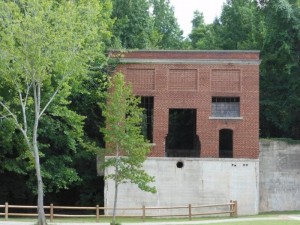
The brick structure at the beginning of the Green Way on Hitchcock Creek, Steele Street, Rockingham, is the last structure remaining from the Pee Dee Mills which operated there.
Hitchcock Creek Blue Trail once essential for pioneers
Hitchcock Creek, Part 1
Today’s use of Hitchcock Creek in Richmond County is mostly recreational. But the Richmond County Historical Society has a different viewpoint.
Only a handful of those putting in their canoe or kayak at Roberdel on the creek – and going the 14 miles to the Pee Dee River – know they are traveling one of the county’s most historic waterways, shadowed in local history only by the Great Pee Dee River.
John Hitchcock, for whom it was named, was among this area’s first settlers. He was a Quaker. After disagreement with his father on religious views, John left his Maryland home in 1738 and came to an area known then as Bladen County – then to become Anson (in 1749), then Richmond (in 1779).
In 1741 he received a King’s Grant for 300 acres along the Pee Dee River. By 1753, John had title to 3,240 acres. He died in 1788 and was buried along with his wife somewhere on that land along the river.
Before he died, land for the Town of Rockingham was bought for a county seat in 1785 between Hitchcock Creek and Falling Creek. His property can be presumed to have been along the creek that bears his name.
Many early settlers came up or down the Pee Dee River and used creeks such as Hitchcock to enter the interior of what is now Richmond County. Records of April 19, 1801, show that a county judge (Court of Common Pleas made up of Justices of the Peace) ordered that Hitchcock Creek be cleared and kept open for navigation of boats and other craft from the Pee Dee River up to Terry’s Mill where today it is Roberdel. That is the same route as Rockingham’s Blue Trail.
In those days with roads and creeks, often clearance and maintenance was the responsibility of adjoining landowners.
John was a Quaker, and he married a Quaker, Mary Ruth Millikin. They were religious farmers. On June 5, 1759, John sold 200 acres on the east side of the Pee Dee River to the Rev. Thomas Moorman, also a Quaker, for use by Quakers. There is an ancient Quaker cemetery on that land now near the Diggs Landing at the end of the Blue Trail.
Quakers were not alone along the creek. In 1767, requests were being made to the Presbyterian Synod in Philadelphia, Pa., for supplies for a gathering of Presbyterians on Hitchcock Creek. They eventually established a Hitchcock Creek Presbyterian Meeting House as well as the Cartledge Creek Meeting House.
And then there was the 1768 Morris Meeting House (Baptist) on Hitchcock Creek and the “regular” Baptist Dockery Meeting House on Cartledge Creek.
Some of these early settlers later moved on to what they considered greener pastures elsewhere, or were divided by loyalties during the Revolutionary War, or by social issues such as slavery which caused many Quakers to move since they opposed it. From this we can gather that many settlers of like religions preferred to settle together.
In addition to being a water source for individual residents near Hitchcock Creek, as the population increased, it took on a commercial nature as well.
Grist mills and other mills took advantage of the dependable flow of water along the creek. In doing so, their dams then restricted use of the creek for transportation.
Today, the only dams remaining are Ledbetter, Roberdel (below which the Blue Trail begins) and Midway, which must be traversed to get to the Pee Dee River. In recent years, the Steele’s Mill Dam in Cordova was removed.
In 1790, Charles Robinson petitioned to Court of Common Pleas for permission to build a grist mill on Hitchcock Creek. It was to be located where later the Pee Dee No. 1 mill was built at the creek’s intersection with today’s Steele Street and the city’s park area and Greenway, which trails into that mill’s old pond bed.
The Historical Society has one of the grist stones from that mill. Robinson’s descendants included the William B. Cole family of Rockingham from whom it was obtained.
For certain there must have been other grist mills also along Hitchcock Creek, however there is no record of them until John Shortridge’s grist and woolen mill of 1850. It was located near where Ledbetter Manufacturing Company later built its dam and mill. The mill is now Carolyn Mills Condominiums.
Yes, that is the same John Shortridge who later founded Hamlet along Marks Creek. An Englishman, he came to Rockingham first to manage the Richmond Mill before expanding his enterprises.
Shortridge moved to Sandhills (Hamlet), gave land to the Seaboard Railroad in 1890, and Hamlet developed into a major railroad center.
Neal Cadieu
